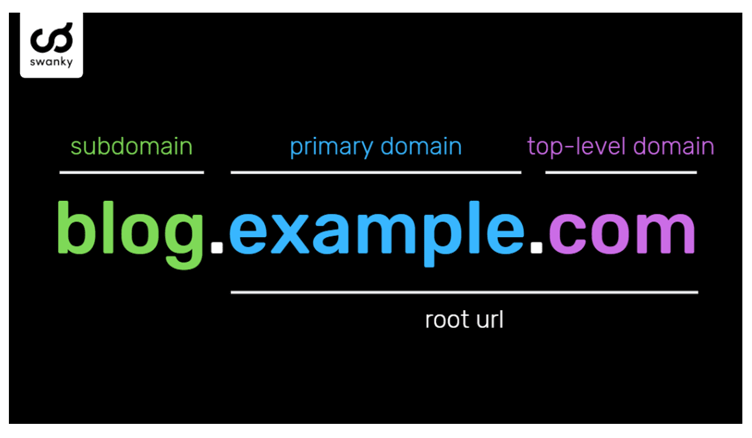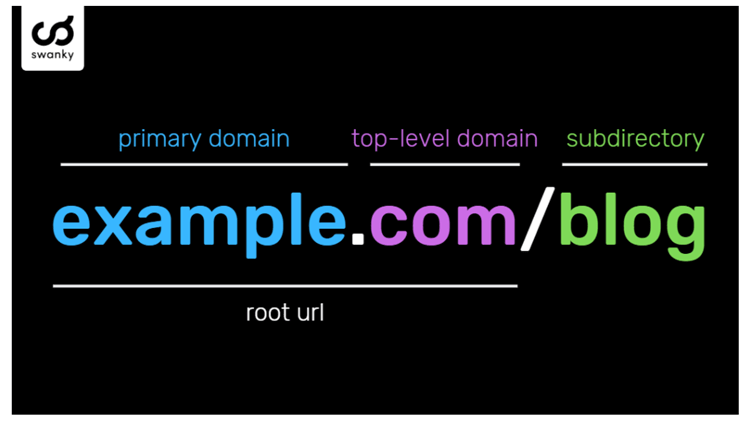What Are Subdomains?

Hand off the toughest tasks in SEO, PPC, and content without compromising quality
Explore ServicesYour website is similar to an iceberg. People only see the most visible parts of your website – your homepage, blogs, product pages, and so on.
There is, however, a much larger underbelly: a web of metadata, XML sitemaps, schema markup, and site architecture that provides the framework for generating a strong search presence. You must account for these factors if you do not want your search performance to sink like the Titanic.
Any website’s guts are a complex web of pages and multiple subdomains, and the structure of those components is critical to SEO success. Google’s algorithms are notoriously cumbersome, so don’t change your site map without first understanding how these changes will affect your site’s ranking, especially when it comes to your main domain versus your subdomains.
One of the most frequent questions asked is, “Exactly what is a subdomain?” An important question, to be sure. Fear not though, for Loganix is here to help!
In this article, we’ve delved into what a subdomain is, why subdomains are important, how subdomains affect SEO and what they’re used for.
First things first, let’s clarify the confusion!
What Are Subdomains?
A subdomain is an extension of your main domain name. Subdomains are used to organize and navigate different sections of web pages in your websites. On your main domain, you can have multiple subdomains or child domains.
Domains are organized into a simple tree structure or hierarchy called the domain name system (DNS). The DNS starts with top-level domains (TLD) which is also referred to as a domain extension like .com or .org, It is sorted into domains and subdomains, and the second-level domain (SLD), which is the distinctive part of the domain name, usually a company or brand name.
According to the cPanel documentation, it is “a subsection of your website that can exist as a new website without a new domain name.”
Let’s take the following example, where the subdomain is indicated to the left of the root URL:
It’s worth mentioning the alternative to using a subdomain is a subdirectory. Some people prefer to create a subdirectory (also known as a subfolder) instead. A subdirectory is a section of a URL that contains a specific subset of content.
In terms of the subdirectory structure, Individual directories are found to the right of the domain, as shown below:
The subdirectory, in this case, is ‘blog.’ Consider the blog to be a folder within the website that serves as a filing cabinet.
Whatever you intend to do with your subdomain, or if you’re unsure whether to publish a specific page under your www subdomain or under a different subdomain, consider your website’s primary goals. You can do this with the help of your web hosting provider.
Why are subdomains Important?
Search Engine Optimization
Subdomains will significantly boost your search ranking and website traffic. Subdomains are recognized by search engines as distinct web addresses from your root domain. As a result, you can use your subdomain to attract new visitors and direct them to your main site.
Easy to follow content
If your main site is an e-commerce site or e-commerce store, you want it to have a single focus. People do not read websites from beginning to end like they do books. Keep it simple and provide your audience with a single and clear call-to-action (CTA). Many people set up subdomains to address specific content that supplements their main site. For example, if you sell beans on your main site, you might think about adding a subdomain about beans cooking.
Improves on budget constraints
Creating an additional subdomain to share your new products and services is a good solution to avoid overwhelming your main site or competing with it for traffic. Not only is it free to create another subdomain, but you’re also not deviating from the main message on your root domain. Essentially, you get multiple domains for the price of one, compared to getting a new domain especially when you want to maintain a tight budget.
Target additional niche
You can reach a niche audience with subdomains that you would not be able to reach with your main site. To target different audiences, you can create multiple subdomains.
Increase the visibility of your brand
Having a subdomain increases the credibility of your brand. With highly specialized subdomains, you can demonstrate your expertise in multiple areas.
Mobile-friendliness
A Google Chrome update in April 2015 prioritized mobile-friendly sites in search rankings. Mobile-friendliness is critical if you want your site to remain competitive in search engine results pages (SERPs). You can set up a subdomain that is optimized for mobile devices.
Subdomains FAQ
Is a subdomain bad for SEO?
Following a Hangout session with Google Webmasters Trends Analyst, John Mueller, in 2016, previous warnings of organic search cannibalization were called into question. He addressed the debate head-on and offered some hope to subdomain users everywhere.
Mueller came to the conclusion that subdomains do not generally harm site rankings. He contended that Google’s algorithms are equally adept at crawling subdomains and subdirectories and making sense of what you’re attempting to accomplish. The search engine recognizes your main domain and subdomain as belonging to the same main website and, as a result, can assign keywords to the root URL.
Having said that, he did warn against the use of wildcard subdomains, which are intended to redirect anyone attempting to access non-existent subdomains to a specific folder. Google’s algorithms have historically struggled to crawl those types of subdomains.
Is subdomain better for SEO?
When content and links are split between a subdomain and the main domain, the overall authority of those two entities is lower than if everything was on the main domain (using subdirectories).
As a result, when relevant subdomains are migrated into subfolders on the main domain, it is common to see an increase in overall organic visibility and traffic (when compared to the two viewed separately).
There are numerous examples of significant gains seen when moving content from a subdomain to subfolders.
Blogs are typically content-rich (often housing the majority of a company’s best content), and that content frequently earns backlinks. In this case, the subdomain has both topical relevance and authority that is closely related to the main domain. As a result, when you create a new subdomain, you’ll need to start acquiring high-quality backlinks that are distinct from your main site.
So, during the migration, the subdirectory inherits the authority (from content and links) and relevance, and when combined with the existing authority of the main domain, the result is an increase in authority (and thus organic visibility) that is greater than when the two are viewed as separate entities.
Essentially, great content that receives a lot of backlinks will almost always contribute to better SEO results when it’s hosted in a subdirectory rather than a subdomain.
How do subdomains affect SEO?
As Matt Cutts explains, Google will treat your subdomains as completely different websites. This means you can establish distinct authority for each of the subdomains you use. Subdomains can have an impact on your SEO efforts in the following ways:
Subdomains have the potential to improve user experience
You will provide a poor user experience if you have a large and confusing site that is difficult to navigate. A poor user experience means that your visitors will spend less time on your site, potentially resulting in lower rankings.
By using subdomains to streamline your site hierarchy, you help users find the information they seek more efficiently, improving your own website’s SEO performance.
Keywords can be inserted into URLs by subdomains
It doesn’t always make sense to include specific keywords in your main URL. Subdomains, on the other hand, provide an additional opportunity to incorporate difficult-to-rank keywords into your domain. Which is usually beneficial to your rankings.
Subdomains have the potential to increase niche authority
Building large-scale authority can be time-consuming. Ranking in niche markets, on the other hand, can take a lot less time and effort. By ranking and establishing domain authority in smaller markets, you will help to reinforce the authority of the primary domain.
What are subdomains used for?
A subdomain is commonly used to logically separate sections of a website. A subdomain can be used to launch a career site (careers.yoursite.com), a forum (forum.yoursite.com), an online store (onlinestore.yoursite.com), or customer support (support.yoursite.com). Subdomains can also be used to create blogs with different themes.
Subdomains can also be used for the following purposes:
- Create multiple language versions of a website (en.yoursite.com).
- Make a website’s mobile version (m.yoursite.com).
- Create a network of unrelated websites. For instance, how to sign up for a WordPress website, WordPress.com account, and set up your own blog on a subdomain (yourblog.wordpress.com).
Should You Make Use of Subdomains?
Hopefully, this article has given you a better understanding of subdomains.
You still could be wondering, should I use subdomains?
You’re probably hoping for a simple answer here, but there isn’t one.
You have to take things on a case-by-case basis with SEO and Google ranking factors, just like everything else. There is no hard and fast rule governing the use of subdomains because, be it a small business or big, the benefits outweigh any potential SEO consequences (either real or perceived).
In other cases, subdomains will not provide any real tangible value over subdirectories that extend from your main domain, so making significant changes to the site structure is pointless. At the end of the day, it all comes down to what makes the most sense for your specific website.
If you have any questions about your own navigation hierarchy or how to optimize your website for maximum ranking opportunities, please feel free to reach out to us at Loganix. We’ll assist you in determining the best approach to achieving your objectives and optimizing your website.
Hand off the toughest tasks in SEO, PPC, and content without compromising quality
Explore ServicesWritten by Adam Steele on August 17, 2021
COO and Product Director at Loganix. Recovering SEO, now focused on the understanding how Loganix can make the work-lives of SEO and agency folks more enjoyable, and profitable. Writing from beautiful Vancouver, British Columbia.





